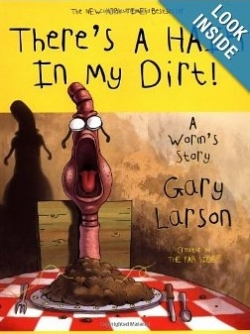Search for Resources
Description
The worm family takes on human characteristics as they are introduced as a mother, father and a typical teenager who hates his worm existence, especially when he finds a hair in his supper. In an effort to teach him a moral lesson the father tells the son a story about a beautiful young maiden named Harriet. Harriet happily skips through life lovingly adoring the creatures that surround her. But unbeknownst to Harriet her idealistic view of nature is very skewed. The "cute" grey squirrels she feeds are aggressive invaders. The tortoise she picks up dies, and the cuddly little mouse she saves from a snake is loaded with viruses which ultimately lead to Harriet's demise. As he listens to the story the teenager discovers that in the web of life all creatures are important, even invertebrates like worms!
Gary Larsen's wit accompanied by the rich illustrations in this book challenges students to rethink their perceptions and ideals about nature. We can love our natural world but we must also respect and understand it. In true Gary Larsen fashion readers are also left wondering about the ultimate question that needs answering. Where did that "hair in my dirt" come from?
General Assessment
Recommendation of how and where to use it
This book would be a valuable addition to any unit with an ecosystems theme. Middle school students could select groups of animals mentioned in the story and categorize them according to trophic level. Then they could create a food web from their organisms, defining the roles of producers, decomposers and consumers. They could expand their investigation by examining a forested or wetland area and then create another food web from all of the organisms they find in a natural habitat.
At the high school level students could read this book as a precursor to a peer debate about the value of nature. Students could explain their own beliefs about the environment and define inaccurate interpretations. Students could also identify ways of maintaining a sustainable environment and actions they could take to help protect nature. Building on the book, students could create their own comic strip by choosing a particular organism and developing a story line that identifies the habitat requirements of their species. The book also contains many technological and scientific terms which students can learn the meanings behind and then use in their own scientific writing.
Relevant Curriculum Units
The following tool will allow you to explore the relevant curriculum matches for this resource. To start, select a province listed below.
- Step 1Select a province
- Alberta
- British Columbia
- Manitoba
- New Brunswick
- Newfoundland & Labrador
- Northwest Territories
- Nova Scotia
- Nunavut
- Step 2Select a grade level
- Grade 7
- Step 3Select a subject
- Science
- Step 4Relevant matches
- Interactions and Ecosystems
- Grade 9
- Step 3Select a subject
- Science
- Step 4Relevant matches
- Biological Diversity
- Knowledge and Employability Science: Biological Diversity (Social and Environmental Contexts Emphasis)
- Ontario
- Step 2Select a grade level
- Grade 7
- Step 3Select a subject
- Science & Technology
- Step 4Relevant matches
- Life Systems: Interactions in the Environment
- Grade 9
- Step 3Select a subject
- Science
- Step 4Relevant matches
- :Biology: Sustainable Ecosystems
- Prince Edward Island
- Quebec
- Step 2Select a grade level
- Grade 7
- Step 3Select a subject
- Science & Technology
- Step 4Relevant matches
- The Living World
- Grade 8
- Step 3Select a subject
- Science & Technology
- Step 4Relevant matches
- The Living World
- Grade 9
- Step 3Select a subject
- Science & Technology
- Step 4Relevant matches
- Applied Science & Technology: The Living World
- Grade 10
- Step 3Select a subject
- Science & Technology
- Step 4Relevant matches
- Applied Science & Technology:The Living World
- Saskatchewan
Themes Addressed
Ecosystems (3)
- Appreciating the Natural World
- Biodiversity
- Interdependence

